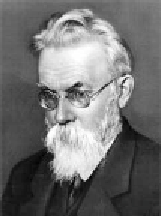Geoscience Reference
In-Depth Information
of Vladimir Ivanovich Vernadsky [VER 29] and not in his Russian
work of 1926 [VER 26] as often thought.
Marine biogeochemistry is the area of biogeochemistry that
focuses on the effects of the activity of marine organisms on the
concentrations of chemical elements in the biosphere, the hydrosphere
and the geosphere and on the cycles of chemical elements between
these reservoirs. Since the end of the Joint Global Ocean Flux Study
(JGOFS) international program in 2003, the boundary between
biological oceanography and marine biogeochemistry has become
blurred and several areas of marine research, such as the
photosynthetic production of organic matter from inorganic
compounds by phytoplankton, known as primary production, are
covered by the two disciplines. Key aspects of marine
biogeochemistry are discussed in the topic
Ocean Biogeochemical
Dynamics
[SAR 06].
Figure 4.1.
Vladimir Ivanovich Vernadsky, 1863-1945, founder
of biogeochemistry (https://en.wikipedia.org/wiki/File:Vernadsky.jpg)
The dissolution of the main atmospheric gases into seawater
provides an example of the differences that exist between the ocean and
other biogeochemical reservoirs. In the atmosphere, these gases are, in
descending order of percentages by volume, N
2
(78.1%), O
2
(20.9%)
2
,
Ar (0.9%) and CO
2
(0.03%) (the percentages cited here are different
from the data in Table 4.2, where they are percentages by mass). The
percentage by volume of a gas in the atmosphere corresponds to its
2 In this chapter, O
2
symbolizes a molecule of free oxygen, also called dioxygen.



